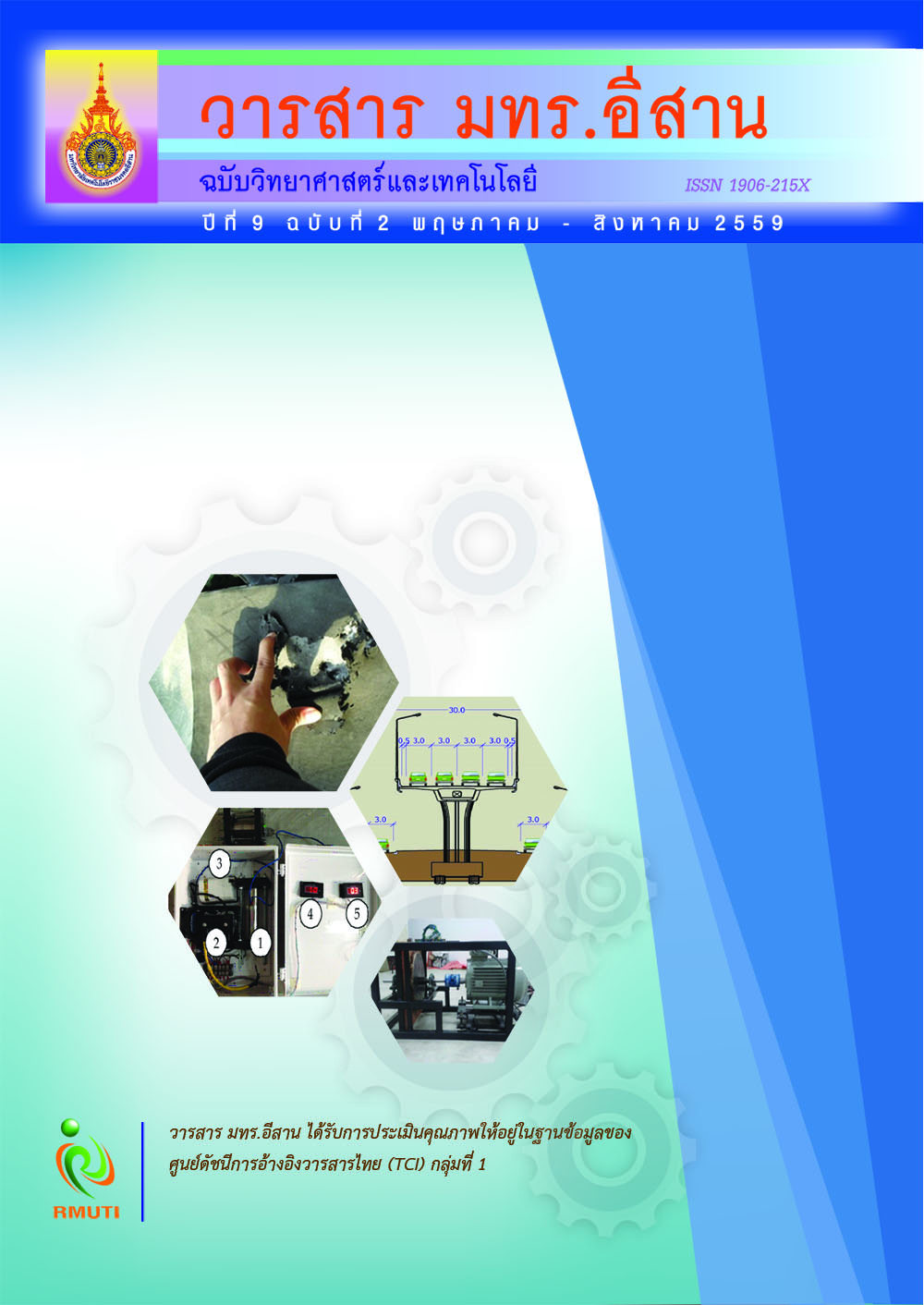การผลิตไฟฟ้าขนาดเล็กจากคลื่นชายฝั่งทะเล The Small Electric Power Generation from Coast Waves
Main Article Content
Abstract
บทคัดย่อ
ปัจจุบันหลายประเทศกำลังหาแหล่งพลังงานทดแทนเพื่อใช้เป็นเชื้อเพลิงในการผลิตไฟฟ้าแทน
แหล่งเชื้อเพลิงประเภทฟอสซิลที่กำลังหมดไปในในอนาคต คลื่นชายฝั่งทะเลถือเป็นแหล่งพลังงานที่น่าสนใจ
ในการผลิตไฟฟ้า เนื่องจากเป็นแหล่งทรัพยากรธรรมชาติที่ไม่มีวันหมด ด้วยเหตุผลนี้ผู้วิจัยจึงสนใจ
การผลิตไฟฟ้าขนาดเล็กจากคลื่นชายฝั่งทะเล โดยทุ่นจะถูกออกแบบให้เคลื่อนที่ ขึ้น - ลง ตามความสูง
ของคลื่น เพื่อไปผลักให้เครื่องกำเนิดไฟฟ้ากระแสตรงหมุน โดยอาศัยเฟืองปรับความเร็วรอบ พลังงาน
ไฟฟ้าที่ผลิตได้จากเครื่องกำเนิดไฟฟ้ากระแสตรงจะถูกประจุเก็บในแบตเตอรี่ขนาด 12 V 5 Ah ผ่านชุดควบคุม
ประจุสำหรับเป็นแหล่งจ่ายพลังงานไฟฟ้าให้กับภาระไฟฟ้า งานวิจัยนี้เลือกใช้หลอดฮาโลเจนขนาด 12 V
20 W เป็นภาระไฟฟ้าพบว่า การผลิตไฟฟ้าจากคลื่นชายฝั่งทะเลสามารถผลิตพลังงานไฟฟ้าและประจุ
พลังงานไฟฟ้าเก็บในแบตเตอรี่ในช่วงเวลากลางวัน ได้เต็มภายใน 1 ชั่วโมง 45 นาที และช่วงเวลากลางคืน
สามารถประจุพลังงานไฟฟ้าได้เต็มภายใน 2 ชั่วโมง โดยสามารถใช้กับหลอดฮาโลเจนขนาด 12 V 20 W
ได้นาน 5 ชั่วโมง เมื่ออยู่ในสภาวะที่ไม่มีคลื่นทะเลสำหรับการผลิตไฟฟ้า
Abstract
Currently, many countries are looking for renewable energy sources to be used as fuel
to produce electricity instead of fossil fuels which is running out in the future.
Coast wave is an interesting source of energy for electric power generation because
of its renewable nature. From this reason, the researcher was interested in a small
electric power generation from coast waves. A buoy was designed to move up and
down according to sea wave for rotating a DC generator by using cog driving mechanism.
The electric energy produced from the DC generator was charged in a 12 V 5 Ah battery
via a charger control for supplying electric loads. This research used a 12 V 20 W halogen
lamp as a load. It was found that the electric power generation from coast waves during
daytime was enough for charging the battery to 100% state of charge within 1 hour
45 minutes while at night time, two hours charging period is required. When there is
no waves, the stored electrical energy could be used to supply a 12 V 20 W halogen lamp
for 5 hours.
Article Details
References
Cuan, B.B., Trevor J.T. Whittaker and Matt, F. (2002). Overview and Initial Operational Experience of the LIMPET Wave Energy Plant. Dept. of Civil Engineering. Queens University Belfast. pp. 3-12
Dorrell, D.G., Halliday, J.R. Miller and P. Findlater, M. (2004). Review of Wave Energy Resource and Oscillating Water Columm Modeling. The 39th International Universities Power Engineering Conference. pp. 120-156
Kitsada, P. and Sompob, P. (2013). Study of Electric Power Generation from Coast Waves.Princess of Naradhiwas University Journal. Vol. 5. No. 3. pp 37-46
Laurent, M., Morten, K. and Peter, F. (2011). Performance Evaluation of the Wavestar Prototype. Aalborg University
Sansiri, S., Somkiat, T., and Nattadate, F. (2012). Feasibility Study of Electrical Power Generation from Wave Energy and Protection Coastal Erosion : Case Study Inner Gulf of Thailand. IE Network Conference. Petchburi. pp. 999-1004


